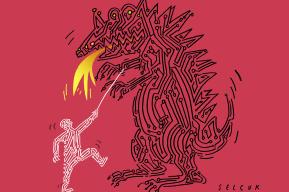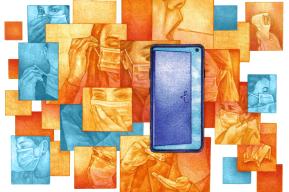观点
公共卫生危机:滋生虚假信息的沃土

2019冠状病毒病大流行期间,虚假信息和阴谋论在社交媒体上大行其道。在非洲和其他一些地方,红茶、苦楝树叶和胡椒汤被吹捧成了治疗COVID-19的灵丹妙药。要遏制这场“信息疫情”,必须增强数字平台的责任感,揭穿虚假新闻并追根溯源,同时提升媒体素养。
迪奥玛·德拉梅
(塞内加尔达喀尔“非洲调查”法语网站记者兼卫生问题研究员,这家非营利组织是非洲首个独立的真相调查机构。)
在2020年之前,人们从未听说过“2019冠状病毒病”(COVID-19),但正是这种不为人知的疾病引发了一场空前的全球公共卫生危机。关于这种新型病毒,还有很多问题有待科学家去寻找答案,包括病毒感染者的免疫力程度、病毒的季节性变化和变异能力。我们对这种致命疾病及其演进过程知之甚少,这导致非洲和其他一些地方的人们对相关信息趋之若鹜,同时也导致了谣言、虚假新闻和虚假信息的泛滥,社交媒体网络在这当中充当了传声筒。
疫情暴发以来,“非洲调查”法语办事处一直在努力打击虚假信息。这家总部设在达喀尔的网站借助专家和研究人员的力量,调查真相,核实新闻报道,前后发布了大约50篇关于COVID-19的文章。
由于治疗这种疾病的有效方法尚未找到,关于所谓神药的文章和信息比比皆是。法国医生兼传染病学家迪迪埃·拉乌尔(Didier Raoult)开展了关于使用羟氯喹(hydroxychloroquine)治疗冠状病毒病的疗效研究,并宣称此法确有其效,随后便有消息通过WhatsApp和Twitter在一些西非国家传播开来,声称苦楝树叶含有氯喹。一时间,这种树叶炙手可热。但奎宁衍生物并非来自植物,而是化学合成的。关于服用红茶、胡椒汤、维生素C和大蒜有助于预防或治疗这种疾病的传言也先后在社交媒体上爆出,对于这些说法,世界卫生组织一一予以驳斥。
阴谋论
在谣言、虚假新闻和虚假信息大肆泛滥的同时,人为操纵或断章取义的图像和视频也随疫情的蔓延传播开来。例如,一些图像和视频打着宣称疫苗或将强制接种的幌子,背地里却在行传播病毒之事。还有一些图像和视频意图散播歧视,特别是针对中国公民的歧视。有一段视频显示,尼日利亚奥约州首府伊巴丹一栋有商铺的建筑物被纵火烧毁,之后便有传言称这是对中国业主的报复。但奥约州政府发布推文澄清,这座建筑物其实是由尼日利亚人所有,楼里80%的雇员都是尼日利亚人。
非洲各地的互联网用户都在转发西方国家针对非洲制造阴谋的消息,以此解释这场大流行病的起源及其传播,实在是荒谬至极。这其实是对联合国秘书长安东尼奥·古特雷斯(António Guterres)在2020年3月27日接受法国国际广播电台采访时所作回答的蓄意歪曲,当时,他告诫称,如不立即采取行动,冠状病毒病可能导致数百万非洲人死亡。无独有偶,关于比尔和梅琳达·盖茨基金会名义上出资支持疫苗,实际上却是意图控制非洲人口的说法也不胫而走。这些消息不仅错得离谱,而且是在故意混淆视听。
谣言四散以及由此造成的后果并不是此次冠状病毒危机期间特有的现象。早在2014年埃博拉疫情期间,部分受影响国家的民众就曾因虚假新闻的煽动蛊惑,纷纷抵制埃博拉病毒防疫战疫策略。
2015年,西尔万·朗德里·费伊(Sylvain Landry Faye)在《人类学与健康》杂志上发表了一篇题为“几内亚—科纳克里埃博拉病毒的‘特异性’和民众的‘沉默以对’”的文章。他在文中解释称,在最开始出现住户家中有人死于埃博拉病毒的情况时,该住户会被视为受到来自神秘力量的惩罚,或是因偷盗或通奸而招致诅咒。这些谣言让人们误以为埃博拉并非真实存在的疾病,进而导致社区拒绝配合国家及其合作伙伴为阻断疫情而推行的应对策略。还有一些谣言说埃博拉治疗中心(ETC)已被染指,是贩运人体和器官的死亡之地。
填补空白
在冠状病毒问题上,Facebook、Messenger、WhatsApp等社交媒体和应用程序赋予了虚假新闻前所未有的影响力。用户不但可以通过这些平台全方位地获取信息,还可以补充、制作并发布消息,其速度之快前所未有。关于伊巴丹火灾的视频在2020年4月20日发布后,短短三天,其转发量就超过了38万次。
其他一些因素对于谣言和虚假新闻的传播也发挥了推波助澜的作用。例如,塞内加尔传统媒体主要关注冠状病毒病感染者的数量及预防病毒传播的最佳方法,但这并不能完全满足民众的需求,人们希望看到关于治疗方法的更多好消息。社交媒体网络正好用来填补这项空白。
虚假新闻通常在志趣相投的个人群体或小圈子中传播,很容易被接受,并且被认为是“有理有据”。语音消息和短信的发布者往往被说成是名流、权威机构或医院的工作人员——顶着假冒的权威提出一些简便易行的解决方案,比如常喝热水或盐水可以给喉咙杀菌消毒。那些所谓的宗教领袖也可能会扮演这种角色。
传统媒体遵循严格的新闻采集、处理与核实流程,而在社交媒体上发布的信息却非如此,甚或存在明显的错误或明显具有误导性,但即便是在这种情况下,普通民众有时也很难区分传统媒体传播的信息和社交媒体上的信息。人们愿意相信,胜过了愿意了解事实,在危机时刻尤其如此。
培养批判性思维
虚假新闻在社交媒体上泛滥成灾,世卫组织称之为“信息疫情”。这种情况促使数字平台发起反击,力图截断虚假信息的恶意传播。具体做法包括推广官方渠道的内容和禁止发布吹嘘神药的广告。“非洲调查”和世界各地致力于挖掘真相的网站等机构的专职调查记者正在努力澄清事实,确保信息来源真实可靠。
要阻击铺天盖地的虚假信息,这些工作显然还不够。联合国在今年5月发起了全球“验证”(Verified)倡议,将组建一支精干的“数字应急”团队,负责清晰、准确地传播关于这场危机的必知信息,让人们更好地认清错误信息所带来的风险。
2019年,Facebook启用了一个新的标记工具,利用这项工具,Instagram用户凡是看到可能包含虚假新闻的帖子,就可以打上标记。此外,吸引人气颇高的社交媒体博主参与提高民众意识并培训社交媒体的管理员和版主学会打击虚假新闻也不失为一个好办法。
一些成功的举措大可推而广之。例如,2020年3月开通的互联网广播电台Wa调频,该电台致力于揭穿科特迪瓦国内关于冠状病毒病的虚假新闻,其节目主要通过Whatsapp播出,这家电台组织了大约200名志愿新闻工作者,深入Yopougon(阿比让的一个工人街区)的大街小巷,通过交叉对比去伪存真,揭露社交媒体上的虚假新闻,开展宣传教育,提高民众认识。
要打击虚假新闻,必须利用这些新闻的传播和滋长渠道,反其道而行之。在非洲和其他地方,还应鼓励民众对于获取的信息进行批判性思考,为此可以鼓励人们质疑信息来源和作者身份。若无此等媒体教育,阴谋论和虚假新闻还将继续泛滥成灾。
了解联合国教科文组织如何阻断冠状病毒病大流行期间虚假信息和虚假新闻在网络和社交媒体网络上的传播。
延伸阅读:
“媒体,净化行动”,联合国教科文组织《信使》,2017年7—9月刊。
“培养批判性思维,抵制虚假新闻”,联合国教科文组织《信使》,2017年7—9月刊。
“验证”,由联合国发起的全球倡议,倡导在冠状病毒病危机期间提供可靠内容 。
订阅联合国教科文组织《信使》,阅读发人深省的时事文章,数字版免费。
在社交网络上关注联合国教科文组织《信使》:微博、微信公众号“联合国教科文信使”、Twitter、Facebook、Instagram。
Diomma Dramé
COVID-19, an unknown disease till 2020, has caused an unprecedented global health crisis. Many questions about this new virus still remain unanswered by scientists – including the nature of immunity of those who have been infected, the seasonality of the virus, and its capacity to mutate. Our lack of knowledge about this disease and its evolution have fuelled a thirst for information, in Africa and elsewhere. It has also led to the proliferation of rumours, fake news and disinformation – with social media networks serving as sounding-boards.
The French-language office of Africa Check has been working to combat disinformation since the beginning of the outbreak. Using specialists and researchers to fact-check and verify stories, the Dakar-based website has published around fifty articles relating COVID-19.
In the absence of effective treatments for the disease, articles and messages about purported miracle cures have proliferated. Following research and claims by a French physician infectious diseases specialist, Didier Raoult, on the use of hydroxychloroquine as a cure for COVID-19, information spread through WhatsApp and Twitter in several West African countries that the leaves of the neem tree contained chloroquine. This sparked a mad rush for these leaves. However, the quinine derivative does not come from a plant, but is obtained through chemical synthesis. Similarly, black tea, pepper soup, vitamin C, and garlic have also been put forward on social media as foods that help prevent or cure the disease. The World Health Organization (WHO) has refuted these claims.
Conspiracy theories
At the same time, the epidemic has led to the dissemination of images and videos that have been manipulated or taken out of context. Some of these have alleged, for example, that vaccination campaigns could be forced, and are actually designed to spread the virus. Others seek to spread discrimination, targeting Chinese nationals in particular. A video showing the burning of a building containing shops in Ibadan, the capital of Oyo State in Nigeria, was wrongly portrayed as a reprisal against its Chinese owner. But a tweet from the Oyo State government clarified that the building was in fact owned by a Nigerian, and eighty per cent of those employed there were Nigerian.
In a spurious attempt to explain the emergence of the pandemic and its spread, stories of a Western conspiracy against Africa have been circulated by internet users across the continent. This was done, in particular, by hijacking the words of United Nations Secretary-General António Guterres, who warned in an interview with Radio France Internationale (RFI) on 27 March 2020 that COVID-19 could kill millions in Africa without immediate action. The theory of a vaccine funded by the Bill and Melinda Gates Foundation to control African populations also spread like wildfire. This information is not only blatantly false, it is deliberately designed to mislead.
The circulation of rumours and their consequences is not specific to the coronavirus crisis. In 2014, fake news provoked resistance to the response strategy to combat the Ebola virus in some of the affected countries.
In an article, “The ‘exceptionality’ of Ebola and popular ‘reticences’ in Guinea-Conakry,” published in 2015 in the journal Anthropologie & Santé, Sylvain Landry Faye explains that the first cases of deaths due to the virus in the same family had been interpreted as a sign of mystical punishment, or a curse brought on by committing a theft or adultery. These rumours fuelled beliefs that the disease was not real – making communities develop attitudes that rejected the response strategy put in place by the state and its partners to stem the epidemic. Other rumours portrayed Ebola Treatment Centres (ETCs) as contamination sites – places of death where bodies and organs were being trafficked.
Filling a void
In the case of coronavirus, social media and apps like Facebook, Messenger, and WhatsApp have given fake news an unprecedented impact. Besides providing global access to information, these platforms also allow their users to add or produce material and circulate it in record time. Posted on 20 April (2020), the video on the Ibadan fire had been shared over 380,000 times three days later.
Other factors have also encouraged the circulation of rumours and fake news. In Senegal, for example, the traditional media’s focus on the number of people infected by COVID-19 and messages about the best way to prevent the spread of the virus did not fully satisfy the needs of citizens – who were looking for more positive news on possible treatments. So social media networks were employed to fill this void.
Fake news, which usually circulates in groups or circles of like-minded individuals, is easily consumed and considered to be “well-sourced” information. Voice messages and texts are often attributed to personalities, authorities or hospital service providers – who use their false authority to offer simple solutions, like regularly drinking hot or salty water to disinfect the throat. So-called religious leaders can also play this role.
It is not always easy for the ordinary citizen to distinguish between information from traditional media – which follows the rigours of news collection, processing, and verification – and information available via social media, even when this is clearly inaccurate or misleading. The desire to believe – especially in times of crisis – can outweigh the desire to be informed.
Developing critical thinking
The avalanche of fake news on social media, which the WHO has labelled as an infodemic, has prompted digital platforms to launch an offensive to stem the viral spread of false information. This is done by promoting content from official sources, or banning advertisements touting miracle cures. Journalists specialized in fact-checking, like those at Africa Check and other fact-checking websites around the world, work hard to correct facts and guarantee reliable sources of information.
However, these efforts to stem the deluge of misinformation are clearly not enough. In May, the UN launched Verified, a global campaign which will create a cadre of “digital first responders” to share compelling, clear and accurate information about the crisis, and raise awareness about the risks of misinformation.
In 2019, Facebook launched a new flagging tool, allowing Instagram users to flag posts that they think contain fake news. It might also be a good idea to involve influential social media bloggers to raise awareness and train their administrators and moderators to combat false news.
Successful initiatives can be replicated. One example is Wa FM, an internet radio station set up in March 2020 to fight fake news on COVID-19 in Côte d’Ivoire. Broadcast primarily on WhatsApp, it relies on a network of around 200 volunteer journalists who walk the streets of Yopougon, a working-class neighbourhood in Abidjan – cross-checking information to correct fake news on social media, and to educate and raise people’s awareness.
To combat fake news, it is necessary to use the same channels that disseminate and feed it. In Africa and elsewhere, it is also necessary to encourage critical thinking in citizens regarding the information they receive. This could be done by encouraging them to question information sources and the identity of the authors. Without this kind of media education, conspiracy theories and fake news will continue to spread unchecked.
Diomma Dramé
Journalist and health researcher at the French-language website of Africa Check, based in Dakar, Senegal. The non-profit is Africa’s first independent fact-checking organization.









